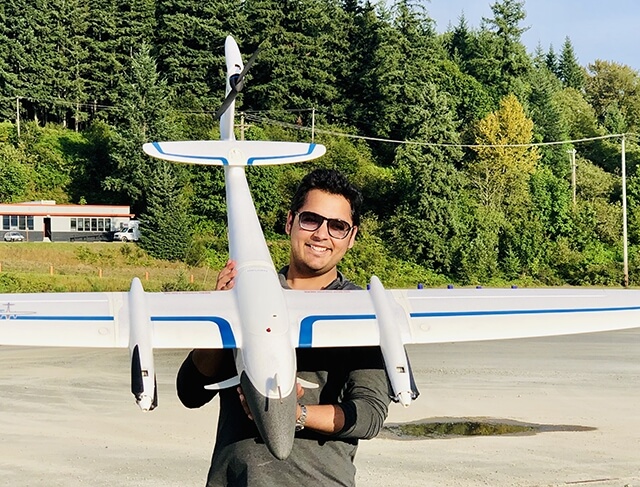While sitting in hopelessly gridlocked traffic on the way to the airport, one may yearn for the ability to summon a flying taxi that could soar above the clogged highway and reach the terminal in a matter of minutes.
That daydream could be a reality. Alumnus Rohit Goyal, M.E. ’14, and his colleagues at Uber Elevate are hard-at-work on a fleet of small, electric air taxis that could be winging passengers to their destinations by 2023.
Goyal, who earned a master’s degree in engineering sciences at the Harvard John A. Paulson School of Engineering and Applied Sciences, is an operations planning strategy lead for Uber Elevate. He leads environmental, weather and airspace constraint projects, and helps draft the blueprint for how the service will operate.
“The market that we are trying to go after doesn’t exist right now, so facing the unknown is an exciting challenge,” he said. “People are enamored by the idea of flying taxis, but there are a lot of fine details on the back end we have to solve for this to actually make sense—how can it work from a business case, from an aerospace case, etc.?”
The Elevate team is working with seasoned aircraft manufacturers to develop electric aircraft which take-off and land vertically, eliminating the need for a runway. These aircraft must be quiet; the noise created by helicopter rotors is one reason they aren’t used more frequently for urban transit, Goyal explained.
Engineers are striving to make aircraft as quiet as possible, incorporating electric propulsion technology pioneered by NASA that will improve both safety and energy efficiency. At Uber, Goyal leads all the operational noise work to ensure minimal noise impact of these aircraft on non-flying public.
“Electric aviation has never been done before for passenger use,” he said. “This could be an important first step toward improving the sustainability of the entire aviation industry. And that’s the part of the job that I enjoy the most, just thinking that there will be a day when the work I’m doing today will make an impact for future generations.”
A desire to make an impact has driven Goyal throughout his career. While earning a bachelor’s degree in environmental engineering at the Indian Institute of Technology, he completed a summer research internship at MIT. He studied how water quality, biomass, and oxygen quantities fluctuate in the Singapore and Johor straits during different seasons.
The applied nature of the work inspired Goyal to return for a master’s degree at Harvard, working in the lab of Daniel Jacob, Vasco McCoy Family Professor of Atmospheric Chemistry and Environmental Engineering. He studied the global environmental impacts of commercial aviation in collaboration with MIT.
Goyal investigated in detail the impact of changes in flight altitude on ozone and methane. His work showed that the altitude at which the change in ozone column becomes zero was about 3 to 4 km higher than the usual cruise altitude of about 30,000 ft. Because of the global nature of this analysis, his work also concluded that certain regions in Asia are more sensitive to aviation emissions than U.S. or Europe.
“That project really came down to understanding the atmospheric chemistry at troposphere and stratosphere and understanding the interactions of ozone and methane at different altitudes” he said. “But if you have to fly higher, you would need more fuel, and there would be some economic cost there. So one needs to work out to see what sort of a balance we could find.”
Goyal worked closely with researchers at the Volpe National Transportation Systems Center during his research project, and joined the center’s aeronautics division after graduation.
He developed environmental monitoring tools for the Federal Aviation Administration, and also contributed to policy papers that helped prepare the federal government to negotiate international climate deals.
Looking to make a faster impact on industry, Goyal joined Booz Allen Hamilton, where he consulted with NASA on urban air mobility policy.
“NASA wanted to understand what their investment and engagement strategies should be in this new Urban Air Mobility landscape,” he said. “My role was to conduct a market study to determine if it was a good enough market for NASA to enter, and how they should invest their resources.”
Goyal has brought his expertise to Uber, where he is answering similar questions for the ride-sharing company.
While he’s excited to see the air taxi model get off the ground, he and his colleagues still have much to do before the anticipated 2023 pilot. Uber Elevate plans to launch in either Los Angeles, Dallas, or Melbourne, Australia.
They must balance quick innovation with an intense focus on safety, since mistakes in air travel could cost lives, he said. Though it is challenging to juggle so many different considerations, the chance to lead a new wave of innovation in the aviation industry brings Goyal a deep sense of satisfaction.
“I always wanted to be close to the latest and greatest technology. The most exciting part for me is to be part of this revolution as is happening,” he said. “Our work could fundamentally change how people move in cities, and even how people live day-to-day. There’s a lot of potential to make a positive change.”
Press Contact
Adam Zewe | 617-496-5878 | azewe@seas.harvard.edu

